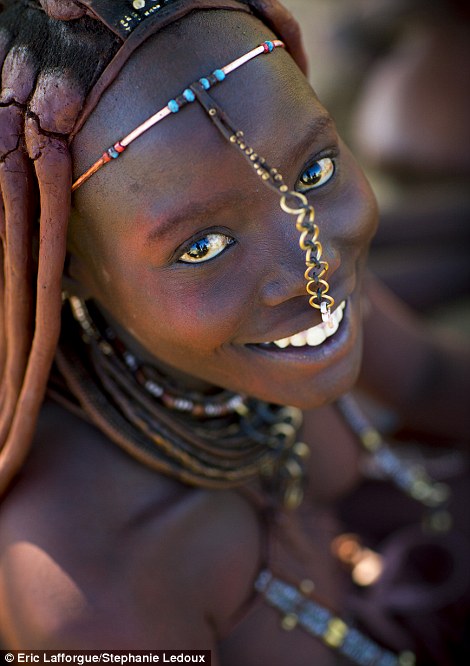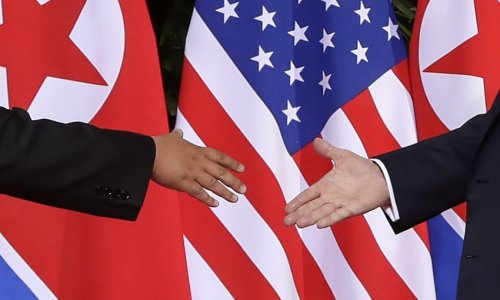Follow us !
That's an unusual look! - PHOTO
World
22:00 | 21.04.2014

That's an unusual look! - PHOTO
Their elaborately braided hair, skin and clothes covered in a mixture of ground red rock and butter, the women of Namibia's Himba tribe are a striking sight.But while the women sport hairstyles of varying degrees of complexity, the men cover their heads with turbans from the moment they marry and never remove them; instead using an arrow-like implement to scratch the hair beneath the turban.'Marriage is important in Himba culture,' explains photographer Eric Lafforgue, 'but extramarital relations are encouraged. Polygamy is the rule for both men and women who can have other partners in addition to their husband.'The Himba's egalitarianism also extends to who gets to be in charge of what, with decisions split between men and women. 'The Himba have a system of dual descent where every person is linked to two distinct groups of relatives: one through the line of the mother and the other through the father,' explains Lafforgue. 'Overall authority is in the hands of the men but economic issues are decided by the women.'The Himba are a tribe of pastoralists who live in Kaokoland, a vast stretch of land in northwestern Namibia and bordered by Angola to the north and the Skeleton Coast and Atlantic Ocean to the west. Like other tribes living in the area, people depend on their cows to live and as a result, a Himba man without a herd of bovine companions isn't considered worthy of respect.'Despite the fact they live in little villages, the Himba are rich people,' adds Lafforgue. 'The herds can be anything up to 200 cows, although they will never says how many cows they have - they keep it secret to avoid thieves.'But while the Himba lifestyle catches the eye, it's the elaborate hairstyles that really set them apart. Styles reference the status of the wearer, with single men wearing a plait called an ondatu on the back of their head.Himba women, by contrast, wear incredibly elaborate styles that change depending on whether or not they're married and on how old they are. 'Himba women use a lot of different things, including hair and straw, to create their dreadlocks,' explains Lafforgue. 'Some Himba even buy Indian hair extensions in town!'A young girl typically has two plaits of braided hair called ozondato, the form of which is decided by her oruzo - the clan she is descended from on her father's side.'A few wear a single plait which means they are one half of a pair of twins, while the smallest children tend to have shaved heads, although some have special haircuts that indicate they belong to a clan where taking care of goats with small ears is taboo - a tradition that extends to eating their meat. 'If you see a teenage girl with strands hanging over her face, it means she has hit puberty and therefore has to hide her face from the men. When a woman has been married for a year or has had a child, she wears the erembe headdress, which is made from animal skin, on top of her head.'Keeping the elaborate dreadlocks in perfect shape is a challenge in itself, with women spending several hours a day tending to their hair and complexion.'Women take several hours each morning for beauty care and sleep on wooden pillows so they don't ruin their hair in the night,' explains Lafforgue. 'The first task is to take care of their dreadlocks. 'Then they cover themselves completely with a mixture made from ground ochre and fat, called otjize. 'It acts as a sunscreen and insect repellent. If they do not have enough butter, they use vaseline. He adds:The red colour that it gives to the skin is considered a sign of beauty and they smear the mixture all over themselves - not only on their skin and hair but also their clothes and jewellery.'Lafforgue is also keen to debunk the myth that Himba people don't wash. 'This is wrong,' he insists. 'If they have access to water, they’ll take a bath, but as they live in arid places, it is a luxury. 'Himbas who don't have water use smoke to purify themselves and their clothes, which they "wash" by putting them into a basket with some incense made from the wood of the commiphora multijuga tree.'Although some Himba wear clothes, among them the clans evangelised by the Germans in the 18th century who wear ornate Victorian ensembles called Hererotracht, for the majority, the focus is on hair and jewelleryWomen wear a large white shell necklace called the ohumba, which is passed from mother to daughter. Equally popular, particularly among married women, are heavy necklaces made from copper or iron wire - much of which is taken from electric fencing.'Some wear keys and bullets as decoration as most of their houses don't have locks,' adds Lafforgue. 'The necklaces of the older women can weigh several kilos but new ones are made with PVC tubes or from things given to them by tourists. That's why you sometimes meet HImba women wearing bracelets that have an Arsenal logo!'Women also use omangetti seeds as decoration because they enjoy the noise they make when they walk. The adult Himba women all have beaded anklets called omohanga, where they hide their money. The anklets are also handy as a protection against venomous animal bites.'Sadly, the Himba's ancient way of life is becoming increasingly threatened with Western mores on dress and lifestyle becoming increasingly influential among younger people.'Everywhere tradition is giving way under the pressure of modern practices and new ideas,' explains Lafforgue. 'Himba women seem to want to keep to the old ways and they resist change more than men do.'Even so, as Lafforgue points out, football shirts are now a common sight - even if the electricity to watch the matches hasn't. 'I met a Himba man in a Brazil shirt,' he adds. 'But he didn't know anything about the football team or the World Cup as TV and electricity still haven't arrived in his village.' For now, at least, it seems the colourful lifestyles of Namibia's Himba look set to continue.(dailymail.co.uk)BakuDaily.Az










